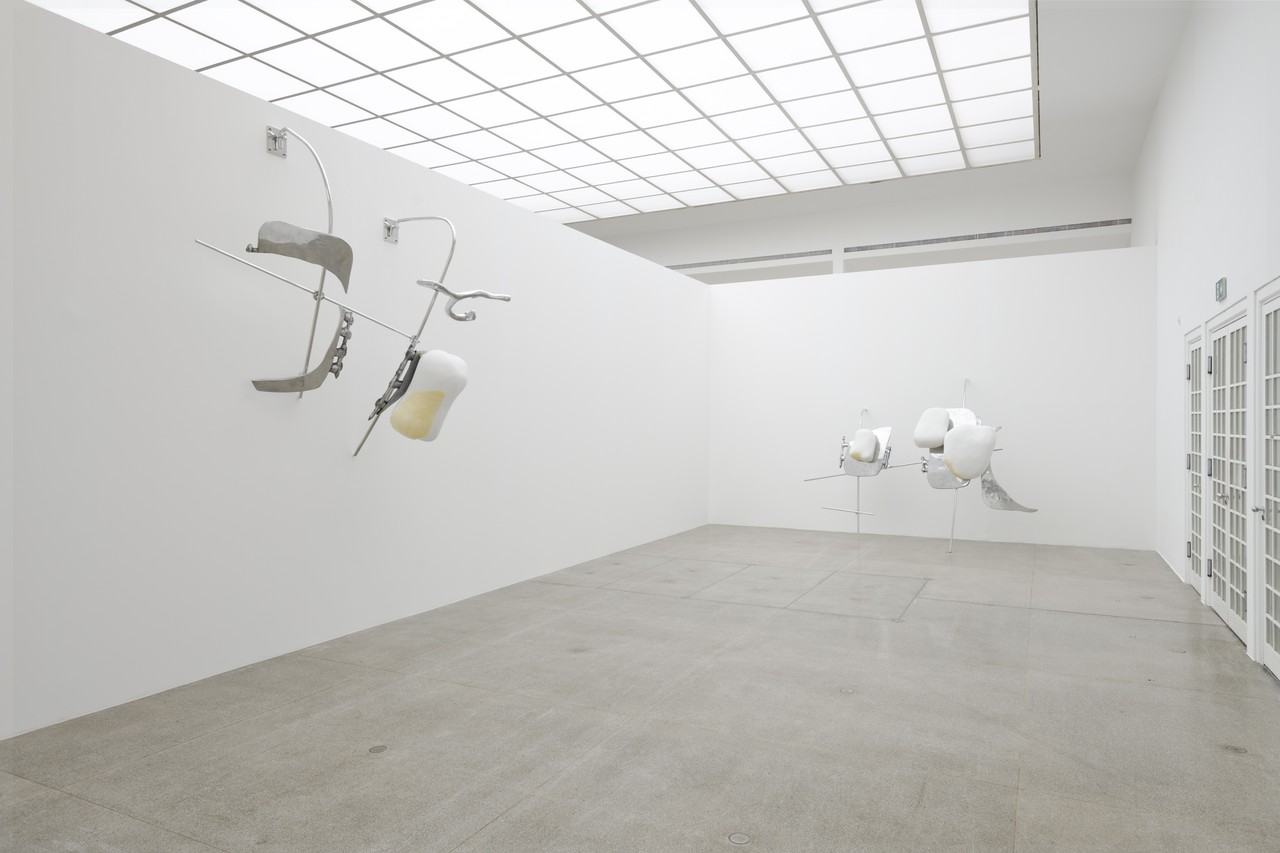Other Mechanisms
Group exhibition curated by Anthony Huberman
29 Jun - 02 Sep 2018

Nairy Baghramian, Scruff of the Neck (LL 17/18/ +1, C), 2016
Courtesy of the artist and Marian Goodman Gallery
exhibition view Other Mechanisms, Secession 2018
photo: Peter Mochi
Courtesy of the artist and Marian Goodman Gallery
exhibition view Other Mechanisms, Secession 2018
photo: Peter Mochi
Other Mechanisms
Group exhibition curated by Anthony Huberman
29 Junе - 02 September 2018
With works by Zarouhie Abdalian, Lutz Bacher, Nairy Baghramian, Eva Barto, Patricia L Boyd, Nina Canell & Robin Watkins, Jay DeFeo, Trisha Donnelly, Harun Farocki, Howard Fried, Aaron Flint Jamison, Jacob Kassay, Garry Neill Kennedy, Frederick Kiesler, Pope.L, Louise Lawler, Sam Lewitt, Park McArthur, Jean-Luc Moulène, Cameron Rowland, Sturtevant, Danh Vo.
“Other Mechanisms” points to a present moment when machines don`t look much like machines. Many aren`t even called machines. Heavy and greasy machinery is absent from the smooth surfaces of digital interfaces and the weightlessness of cloud computing. Tool, appliance, device, apparatus, instrument, computer, hardware, software, program, server, processor, microchip, setting, algorithm, infrastructure, system, logistic, protocol, parameter - the terms for today`s machines accumulate, evolve, and overlap.
Machines are part of the air we breathe, overseeing our lives and our bodies, from the way we communicate and consume to the way we trade and travel. Some are made of metal, but many others ae made of rules or algorithms, which are infinitely more fluid and flexible. Some are objects or devices, but others are systems and infrastructures – a machine can be a thing as well as a method for organizing things. Objects yield to infrastructure. Work turns to management. Machines become mechanisms.
The work in this exhibition reflect on what it could mean to contest the regime of the machine. They compromise its tools, misuse its technologies, reroute its engineering, complicate its measurements. These other mechanisms add detours or dead ends to circulation routes, or insert delinquent trajectories that create distortions over time. They are made of knots, blanks, and incompatible settings. They demand more from their “users”, forgoing protocols of convenience and immediate intelligibility. They reinsert the awkwardness of the human body, with all of its irregularities and inefficiencies.
Machines, like all tools, have their agendas. They embody and enforce specific regimes. They have trained us to embrace and enjoy a life of seamless connectivity and complete flexibility. They have taught us to value efficiency and standardization. They live within the bloodstream of our subjectivities, our policies, and our politics.
Art can`t stop the machine – nothing can. The question is not whether or not to embrace the machine – it`s too late for that – but how to complicate it by testing existing systems with impossible tools and elaborate protocols that misalign outputs from their inputs.
Anthony Huberman
“Other Mechanisms” is a revised and extended version of the exhibition “Mechanisms” that was on view at the CCA Wattis Institute in San Francisco from October 2017 through February 2018.
Group exhibition curated by Anthony Huberman
29 Junе - 02 September 2018
With works by Zarouhie Abdalian, Lutz Bacher, Nairy Baghramian, Eva Barto, Patricia L Boyd, Nina Canell & Robin Watkins, Jay DeFeo, Trisha Donnelly, Harun Farocki, Howard Fried, Aaron Flint Jamison, Jacob Kassay, Garry Neill Kennedy, Frederick Kiesler, Pope.L, Louise Lawler, Sam Lewitt, Park McArthur, Jean-Luc Moulène, Cameron Rowland, Sturtevant, Danh Vo.
“Other Mechanisms” points to a present moment when machines don`t look much like machines. Many aren`t even called machines. Heavy and greasy machinery is absent from the smooth surfaces of digital interfaces and the weightlessness of cloud computing. Tool, appliance, device, apparatus, instrument, computer, hardware, software, program, server, processor, microchip, setting, algorithm, infrastructure, system, logistic, protocol, parameter - the terms for today`s machines accumulate, evolve, and overlap.
Machines are part of the air we breathe, overseeing our lives and our bodies, from the way we communicate and consume to the way we trade and travel. Some are made of metal, but many others ae made of rules or algorithms, which are infinitely more fluid and flexible. Some are objects or devices, but others are systems and infrastructures – a machine can be a thing as well as a method for organizing things. Objects yield to infrastructure. Work turns to management. Machines become mechanisms.
The work in this exhibition reflect on what it could mean to contest the regime of the machine. They compromise its tools, misuse its technologies, reroute its engineering, complicate its measurements. These other mechanisms add detours or dead ends to circulation routes, or insert delinquent trajectories that create distortions over time. They are made of knots, blanks, and incompatible settings. They demand more from their “users”, forgoing protocols of convenience and immediate intelligibility. They reinsert the awkwardness of the human body, with all of its irregularities and inefficiencies.
Machines, like all tools, have their agendas. They embody and enforce specific regimes. They have trained us to embrace and enjoy a life of seamless connectivity and complete flexibility. They have taught us to value efficiency and standardization. They live within the bloodstream of our subjectivities, our policies, and our politics.
Art can`t stop the machine – nothing can. The question is not whether or not to embrace the machine – it`s too late for that – but how to complicate it by testing existing systems with impossible tools and elaborate protocols that misalign outputs from their inputs.
Anthony Huberman
“Other Mechanisms” is a revised and extended version of the exhibition “Mechanisms” that was on view at the CCA Wattis Institute in San Francisco from October 2017 through February 2018.
